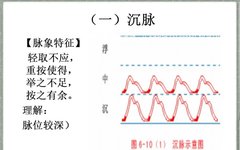(1) Deep Pulse
1. Characteristics of the Pulse
Light pressure does not respond, heavy pressure causes a response, insufficient when lifted, excessive when pressed (Interpretation: the pulse is relatively deep)
2. Clinical Significance
Commonly seen in interior syndromes; strong indicates interior excess, weak indicates interior deficiency; normal pulse can also be observed.
Tips: Pathogenic factors are in the interior, and the body’s righteous qi is insufficient, leading to a struggle between the pathogenic and the righteous qi reaching the hands.
3. Pulse Analysis
Pathogenic factors cause stagnation of qi and blood internally, or yang deficiency leads to insufficient lifting power.
A deep pulse without clinical symptoms is not necessarily a disease; it can be seen in normal individuals. For example, in obese individuals, the muscle is thick, and the pulse vessels are deep, hence the pulse is often deep. In winter, when qi and blood are stored, the pulse tends to be deep as well.
Additionally, some individuals may have a deep and fine pulse in both hands and six positions without symptoms, referred to as “six yin pulses,” which is also a normal physiological phenomenon.
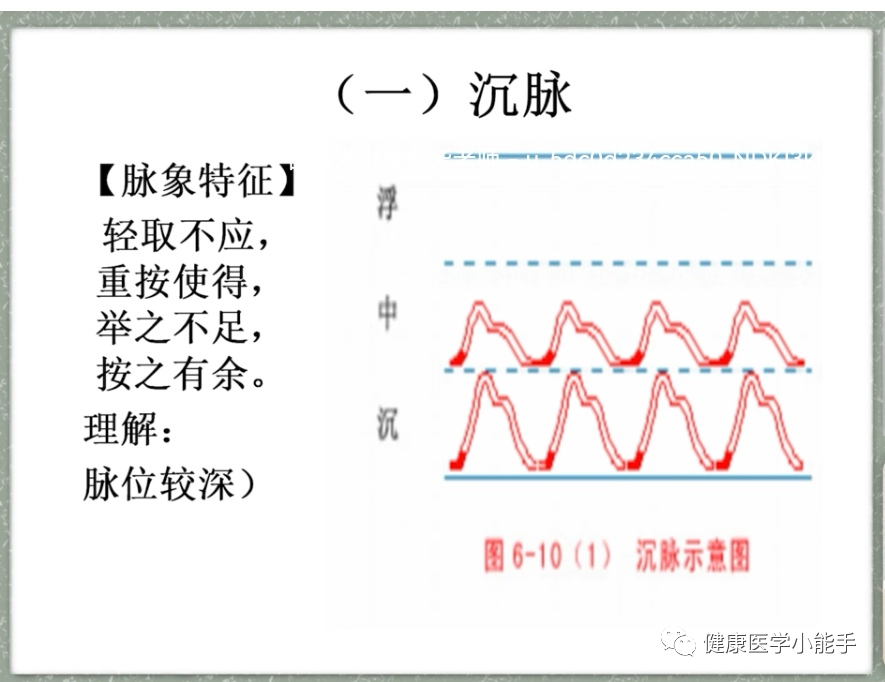
(2) Weak Pulse
1. Characteristics of the Pulse
Extremely soft and deep fine pulse is termed weak pulse; it is obtained by deep pressure, fine and without strength (distinguished from the soft pulse in floating pulses).
2. Clinical Significance
Indicates deficiency of yang qi or both qi and blood; blood deficiency leads to insufficient filling of the pulse vessels, and yang qi deficiency leads to weak pulsation, commonly seen in individuals with prolonged illness and weakness.
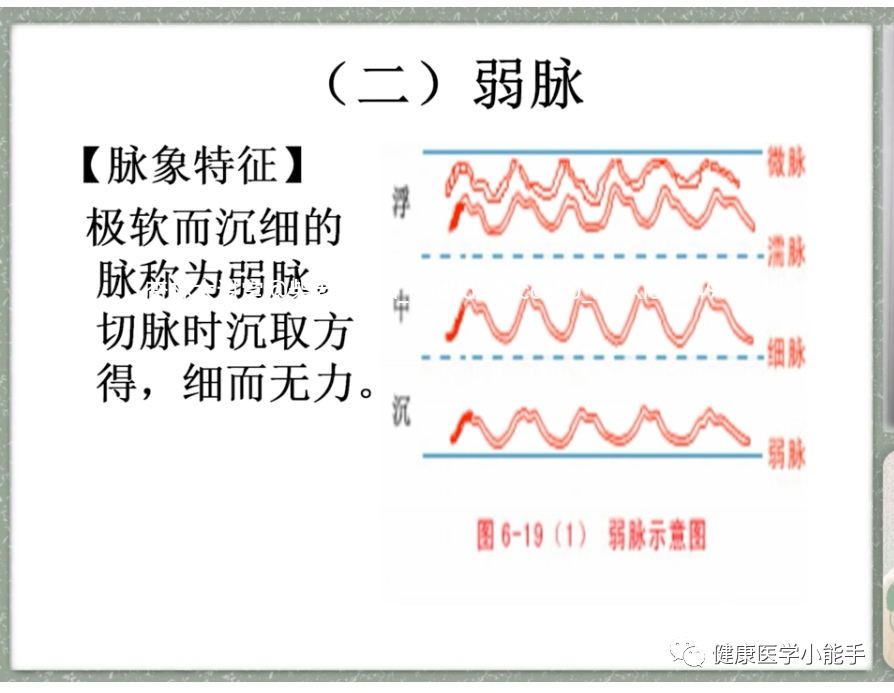
(3) Hidden Pulse
(Meaning: hidden and concealed)
1. Characteristics of the Pulse
Hidden pulse is characterized by being deeper and more concealed than the deep pulse; it requires heavy pressure on the bone to respond, and may even be hidden and not present.
2. Clinical Significance
Commonly seen in patients with closed pathogenic factors, syncope, and painful diseases, often due to hidden pathogenic qi, preventing the pulse qi from being expressed.
In acute illness, the appearance of a hidden pulse indicates excess yin and deficiency of yang, or an imbalance of yin and yang, often a precursor to syncope.
In chronic illness, it indicates deficiency of qi and blood, and symptoms of yin dryness and yang exhaustion.
<Pulse Simplified Supplement> states that prolonged hidden pulse leads to collapse, indicating that hidden pulse is a sign of severe and worsening disease; in critically ill patients, the hidden pulse often appears simultaneously in both hands at the cun position, and even the Tai Xi (Tai Xi pulse) and Die Yang (Die Yang pulse) may not be evident, which differs from the absence of pulse due to vascular lesions that occur in a specific limb, while other pulse positions remain normal.
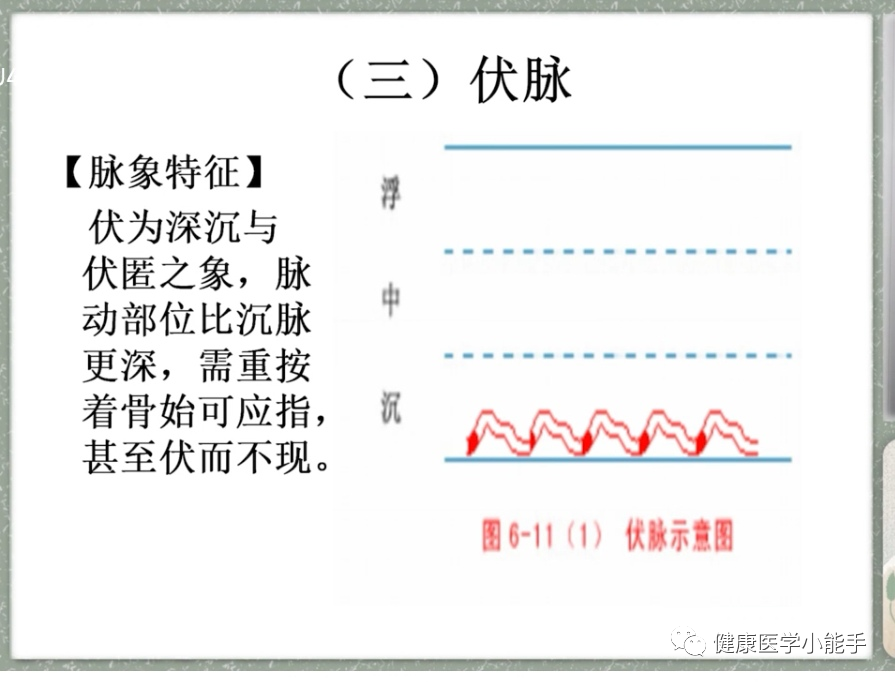
(4) Firm Pulse
1. Characteristics of the Pulse
The pulse is deep, solid, large, and taut; it does not respond to light or moderate pressure, and is firm and immovable, also known as deep taut solid pulse.
2. Clinical Significance
Caused by accumulation of internal cold and sinking of yang qi; commonly seen in conditions of excess internal cold, such as hernias and abdominal masses.
Tips: Excess cold has penetrated to the bones and tendons, especially in blood cold conditions, where there may be tumors in the body, such as in the liver or stomach.
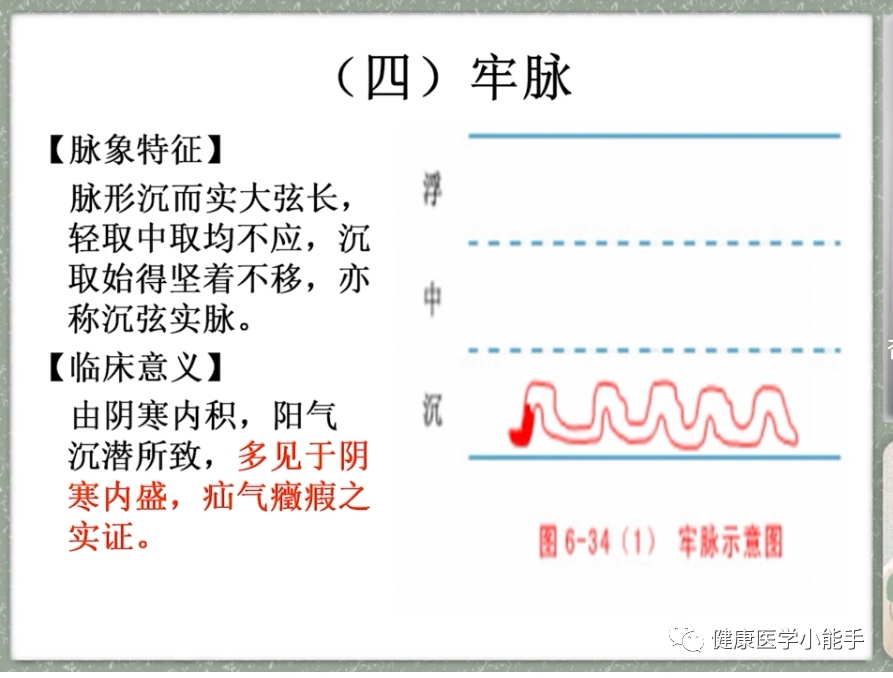
3. Slow Pulse Types
(Slow, sluggish, rough, knotty)
(1) Slow Pulse
1. Characteristics of the Pulse
The pulse is slow, with less than four beats per breath (Interpretation: heart rate below 60 beats per minute, bradycardia).
2. Clinical Significance
Commonly seen in cold syndromes; a slow and strong pulse indicates excess cold, while a slow and weak pulse indicates deficiency cold.
Also observed in conditions of pathogenic heat accumulation.
Tips: The speed of blood flow decreases, and there is cold pathogenic factor in the vessels.
3. Pulse Analysis
Excess cold leads to loss of yang’s ability to circulate, or yang deficiency leads to loss of warmth and movement, resulting in a slow pulse.
Tips: A person in deep sleep may exhibit a slow pulse, generally a sluggish pulse. After excessive exercise, if one suddenly stops to rest, the pulse may drop suddenly, leading to a slow pulse.
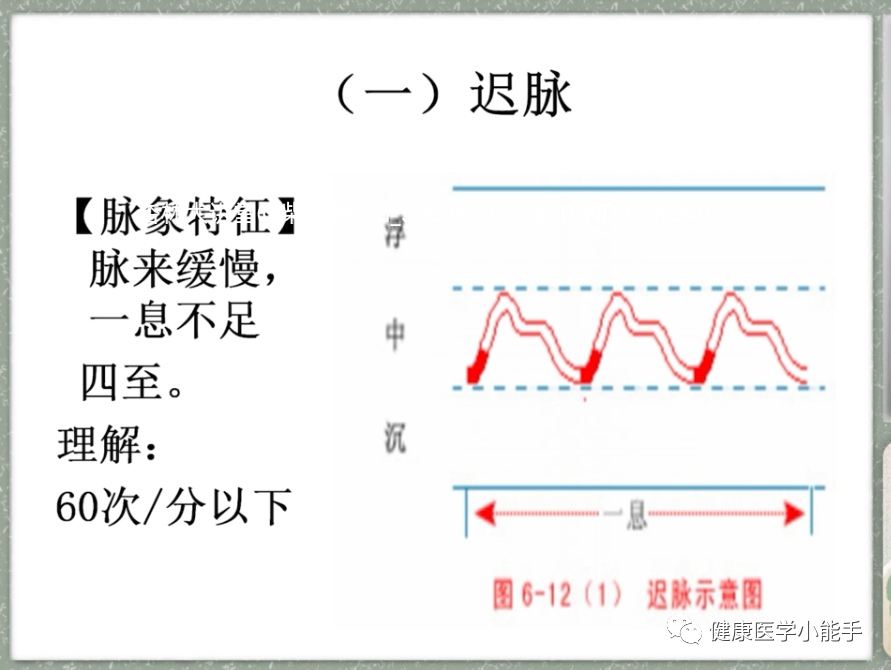
1. Characteristics of the Pulse
Extremely fine and soft, almost imperceptible, as if it is there and not there.
2. Clinical Significance
Often indicates severe deficiency of yin, yang, qi, and blood, with weak pulsation; in chronic illness, it indicates that the righteous qi is about to collapse, while in new illness, it indicates sudden loss of yang qi.
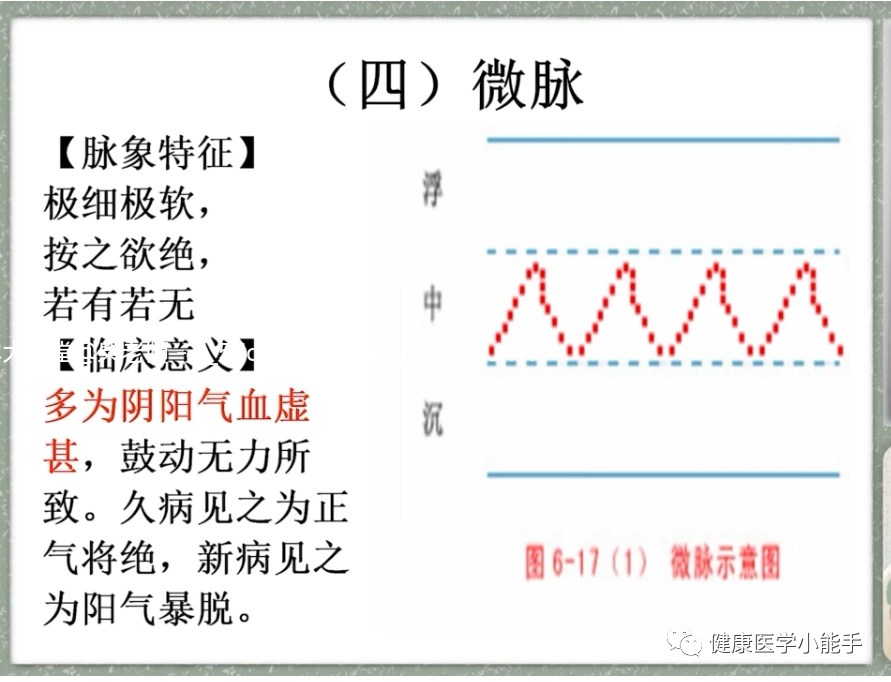
(5) Short Pulse
1. Characteristics of the Pulse
Both ends are short, unable to fill the entire area; a short pulse is one that feels shorter than normal.
Tips: Three fingers should be placed together to take the pulse.
2. Clinical Significance
A strong short pulse indicates qi stagnation, while a weak short pulse indicates qi deficiency. Insufficient qi leads to weak blood circulation, hence the pulse is short and weak, known as “short indicates qi disease.”
It can also be due to qi stagnation and blood stasis, or phlegm accumulation and food stagnation, leading to the pulse qi not extending, resulting in a short pulse; however, a short pulse can be strong, so a short pulse should not be generalized as insufficient; attention should be paid to the strength or weakness of the pulse.
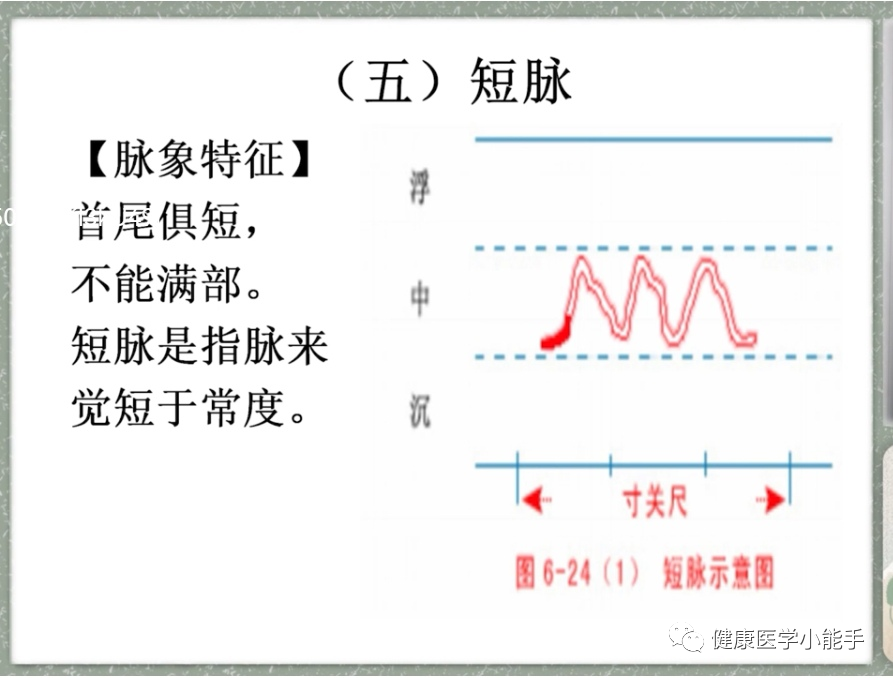
The pulse is a type of pulse that appears when a disease is critical, characterized by lack of stomach, lack of spirit, and lack of root. Such as shrimp pulse, leaking roof pulse, stone bounce pulse, etc.
Tips: Lack of stomach means unable to achieve a gentle and strong pulse, lack of spirit means no strength, and lack of root means this pulse cannot be felt.
Based on the main morphological characteristics of the true organ pulse, it can be roughly divided into three categories:
1. Pulse without Stomach: The pulse without fear is characterized by lack of harmony, with a firm and strong beat as the main feature.
(1) Yan Dao Pulse: The pulse comes quickly and taut, like following the edge of a knife.
(2) Zhuan Dou Pulse: The pulse is short and firm, like coix seeds.
(3) Tan Shi Pulse: Rapid and firm, like a bouncing stone.
Clinical indication: Pathogenic factors overpower the righteous qi, and stomach qi cannot follow, indicating a critical condition of the heart, liver, kidney, etc.
2. Rootless Pulse
The rootless pulse is characterized by being weak and large without a root or responding weakly.
(1) Fu Fei Pulse: Extremely floating and rapid, to the point of being uncountable, like boiling water floating without a root, indicating extreme yang heat and depletion of yin fluids.
(2) Yu Xiang Pulse: The pulse is on the skin, with a fixed head and a tail, like a fish swimming in water.
(3) Xia You Pulse: The pulse is on the skin, like a shrimp swimming in water, sometimes leaping away and then returning, accompanied by signs of rapid agitation.
All indicate extreme cold of the three yin, with loss of yang to the outside, and signs of floating yang.
3. Spiritless Pulse: Characterized by disordered rhythm and scattered pulse shape.
(1) Que Zhuo Pulse: The pulse is rapid and irregular, like a bird pecking, with three to five beats not in sync, stopping and resuming, resembling a bird pecking at food.
(2) Wu Lou Pulse: Like the remaining drips from a leaking roof.
(3) Jie Suo Pulse: The pulse comes and goes, sometimes sparse and sometimes dense, like a tangled rope.
The above pulse types are mainly caused by the decline of spleen and stomach, and kidney yang qi, indicating a scattered spirit and imminent end of life.

